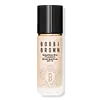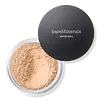Bobbi Brown Weightless Skin Foundation SPF 15 Versus bareMinerals Original Loose Powder Foundation SPF 15
What's inside
What's inside
 Key Ingredients
Key Ingredients

 Benefits
Benefits

 Concerns
Concerns

 Ingredients Side-by-side
Ingredients Side-by-side

Ethylhexyl Methoxycinnamate 6.7%
UV AbsorberTitanium Dioxide 1.6%
Cosmetic ColorantWater
Skin ConditioningDimethicone
EmollientGlycerin
HumectantTrimethylsiloxysilicate
EmollientCetyl PEG/PPG-10/1 Dimethicone
EmulsifyingButylene Glycol
HumectantPolymethylsilsesquioxane
Polyglyceryl-3 Diisostearate
EmulsifyingSodium Chloride
MaskingAcetyl Glucosamine
Skin ConditioningDisteardimonium Hectorite
StabilisingLaminaria Saccharina Extract
Skin ProtectingLavandula Angustifolia Oil
MaskingLavandula Hybrida Oil
EmollientHoney Extract
HumectantButyl Avocadate
Skin ConditioningCaprylyl Glycol
EmollientDisodium Stearoyl Glutamate
CleansingSodium Hyaluronate
HumectantSalicylic Acid
MaskingMethoxy Amodimethicone/Silsesquioxane Copolymer
Skin ConditioningAluminum Hydroxide
EmollientSilica
AbrasivePentaerythrityl Tetra-Di-T-Butyl Hydroxyhydrocinnamate
AntioxidantPolysilicone-11
Citric Acid
BufferingSodium Hydroxide
BufferingHexylene Glycol
EmulsifyingStearic Acid
CleansingLinalool
PerfumingLinalyl Acetate
MaskingBHT
AntioxidantTocopheryl Acetate
AntioxidantDisodium EDTA
Phenoxyethanol
PreservativeMica
Cosmetic ColorantCI 77891
Cosmetic ColorantCI 77491
Cosmetic ColorantCI 77492
Cosmetic ColorantCI 77499
Cosmetic ColorantEthylhexyl Methoxycinnamate 6.7%, Titanium Dioxide 1.6%, Water, Dimethicone, Glycerin, Trimethylsiloxysilicate, Cetyl PEG/PPG-10/1 Dimethicone, Butylene Glycol, Polymethylsilsesquioxane, Polyglyceryl-3 Diisostearate, Sodium Chloride, Acetyl Glucosamine, Disteardimonium Hectorite, Laminaria Saccharina Extract, Lavandula Angustifolia Oil, Lavandula Hybrida Oil, Honey Extract, Butyl Avocadate, Caprylyl Glycol, Disodium Stearoyl Glutamate, Sodium Hyaluronate, Salicylic Acid, Methoxy Amodimethicone/Silsesquioxane Copolymer, Aluminum Hydroxide, Silica, Pentaerythrityl Tetra-Di-T-Butyl Hydroxyhydrocinnamate, Polysilicone-11, Citric Acid, Sodium Hydroxide, Hexylene Glycol, Stearic Acid, Linalool, Linalyl Acetate, BHT, Tocopheryl Acetate, Disodium EDTA, Phenoxyethanol, Mica, CI 77891, CI 77491, CI 77492, CI 77499
 Reviews
Reviews

Ingredients Explained
These ingredients are found in both products.
Ingredients higher up in an ingredient list are typically present in a larger amount.
Mica is a naturally occurring mineral used to add shimmer and color in cosmetics. It can also help improve the texture of a product or give it an opaque, white/silver color.
Serecite is the name for very fine but ragged grains of mica.
This ingredient is often coated with metal oxides like titanium dioxide. Trace amounts of heavy metals may be found in mica, but these metals are not harmful in our personal products.
Mica has been used since prehistoric times throughout the world. Ancient Egyptian, Indian, Greek, Roman, Aztec, and Chinese civilizations have used mica.
Learn more about MicaTitanium dioxide is a mineral UV filter widely used in sunscreens and cosmetics.
It is one of only two UV filters officially classified as “mineral” by regulatory agencies, the other being zinc oxide.
Titanium dioxide provides broad-spectrum protection mostly in the UVB and UVAII range, with some protection in the UVAI range.
While its UVA protection isn’t as strong as zinc oxide’s, the difference is minor.
A common myth is that mineral UV filters reflect UV light. However, modern research shows titanium dioxide absorbs UV radiation like chemical filters (~95% absorption & 5% reflection).
Thanks to its non-irritating nature, titanium dioxide is suitable for sensitive, acne-prone, or redness-prone skin. It is unlikely to cause "eye sting" like other sunscreen ingredients.
A major drawback of this ingredient is its white cast and thick texture. This is why mineral sunscreens often leave a white cast and are less cosmetically elegant than chemical/hybrid sunscreens.
To improve white cast and spreadability, micronized or nano-sized titanium dioxide is often used.
There are ongoing concerns surrounding nano-titanium oxide's impact on marine ecosystems.
There is no conclusive evidence that any form of titanium oxide (or any other sunscreen ingredients) will cause harm to marine ecosystems or coral reefs. The science is still developing but many consumers are keeping a close eye on this issue.
Please note, many destinations have reef-safety sunscreen rules. For instance, the U.S. Virgin Islands advises all visitors to use non-nano mineral sunscreens.
Nano mineral sunscreens once raised safety concerns about absorption into skin.
Extensive research has shown that they do not penetrate healthy or damaged skin; they remain safely on the surface and the top layer of dead skin (stratum corneum).
You'll likely find titanium dioxide bundled with alumina, silica, or dimethicone. These ingredients help make titanium dioxide highly photostable; this prevents it from interacting with other formula components under UV light.
Learn more about Titanium Dioxide